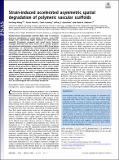| dc.contributor.author | Wang, Peijiang | |
| dc.contributor.author | Ferralis, Nicola | |
| dc.contributor.author | Conway, Claire | |
| dc.contributor.author | Grossman, Jeffrey C. | |
| dc.contributor.author | Edelman, Elazer R | |
| dc.date.accessioned | 2018-12-04T18:09:56Z | |
| dc.date.available | 2018-12-04T18:09:56Z | |
| dc.date.issued | 2018-03 | |
| dc.identifier.issn | 0027-8424 | |
| dc.identifier.issn | 1091-6490 | |
| dc.identifier.uri | http://hdl.handle.net/1721.1/119420 | |
| dc.description.abstract | Polymer-based bioresorbable scaffolds (BRS) seek to eliminate long-term complications of metal stents. However, current BRS designs bear substantially higher incidence of clinical failures, especially thrombosis, compared with metal stents. Research strategies inherited from metal stents fail to consider polymer microstructures and dynamics––issues critical to BRS. Using Raman spectroscopy, we demonstrate microstructural heterogeneities within polymeric scaffolds arising from integrated strain during fabrication and implantation. Stress generated from crimping and inflation causes loss of structural integrity even before chemical degradation, and the induced differences in crystallinity and polymer alignment across scaffolds lead to faster degradation in scaffold cores than on the surface, which further enlarge localized deformation. We postulate that these structural irregularities and asymmetric material degradation present a response to strain and thereby clinical performance different from metal stents. Unlike metal stents which stay patent and intact until catastrophic fracture, BRS exhibit loss of structural integrity almost immediately upon crimping and expansion. Irregularities in microstructure amplify these effects and can have profound clinical implications. Therefore, polymer microstructure should be considered in earliest design stages of resorbable devices, and fabrication processes must be well-designed with microscopic perspective. Keywords: bioresorbable scaffolds; Raman spectroscopy; degradation; structural deformation; microstructure heterogeneities; polymer | en_US |
| dc.description.sponsorship | National Institutes of Health (U.S.) (Grant R01 GM 49039) | en_US |
| dc.publisher | National Academy of Sciences (U.S.) | en_US |
| dc.relation.isversionof | http://dx.doi.org/10.1073/PNAS.1716420115 | en_US |
| dc.rights | Article is made available in accordance with the publisher's policy and may be subject to US copyright law. Please refer to the publisher's site for terms of use. | en_US |
| dc.source | PNAS | en_US |
| dc.title | Strain-induced accelerated asymmetric spatial degradation of polymeric vascular scaffolds | en_US |
| dc.type | Article | en_US |
| dc.identifier.citation | Wang, Pei-Jiang et al. “Strain-Induced Accelerated Asymmetric Spatial Degradation of Polymeric Vascular Scaffolds.” Proceedings of the National Academy of Sciences 115, 11 (February 2018): 2640–2645 © 2018 National Academy of Sciences | en_US |
| dc.contributor.department | Massachusetts Institute of Technology. Institute for Medical Engineering & Science | en_US |
| dc.contributor.department | Massachusetts Institute of Technology. Department of Materials Science and Engineering | en_US |
| dc.contributor.mitauthor | Wang, Peijiang | |
| dc.contributor.mitauthor | Ferralis, Nicola | |
| dc.contributor.mitauthor | Conway, Claire | |
| dc.contributor.mitauthor | Grossman, Jeffrey C. | |
| dc.contributor.mitauthor | Edelman, Elazer R | |
| dc.relation.journal | Proceedings of the National Academy of Sciences | en_US |
| dc.eprint.version | Final published version | en_US |
| dc.type.uri | http://purl.org/eprint/type/JournalArticle | en_US |
| eprint.status | http://purl.org/eprint/status/PeerReviewed | en_US |
| dc.date.updated | 2018-12-03T21:09:05Z | |
| dspace.orderedauthors | Wang, Pei-Jiang; Ferralis, Nicola; Conway, Claire; Grossman, Jeffrey C.; Edelman, Elazer R. | en_US |
| dspace.embargo.terms | N | en_US |
| dc.identifier.orcid | https://orcid.org/0000-0003-2021-9192 | |
| dc.identifier.orcid | https://orcid.org/0000-0003-4148-2424 | |
| dc.identifier.orcid | https://orcid.org/0000-0003-4236-2280 | |
| dc.identifier.orcid | https://orcid.org/0000-0003-1281-2359 | |
| dc.identifier.orcid | https://orcid.org/0000-0002-7832-7156 | |
| mit.license | PUBLISHER_POLICY | en_US |
